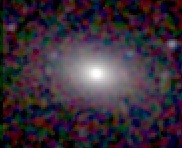NGC 5114 facts for kids
NGC 5114 is a fascinating galaxy that looks a bit like a lens. It's called a lenticular galaxy because of its shape. This amazing galaxy is found in the Centaurus constellation, which is a group of stars that look like a centaur (a mythical creature that is half-human, half-horse).
NGC 5114 is very far away from us, about 170 million light-years. To give you an idea, a light-year is the distance light travels in one year, which is a really, really long way! This galaxy was first spotted by a famous astronomer named John Herschel in 1836.
Contents
What is NGC 5114?
NGC 5114 is a type of galaxy known as a lenticular galaxy. Imagine a spiral galaxy (like our own Milky Way) that has lost its spiral arms. That's kind of what a lenticular galaxy looks like! They have a bright bulge in the middle, just like spiral galaxies, but they don't have those pretty, swirling arms.
Why are Lenticular Galaxies Special?
Lenticular galaxies are often seen as a middle ground between spiral galaxies and elliptical galaxies. Elliptical galaxies are shaped like giant, stretched-out balls. Scientists believe that lenticular galaxies might have formed when two spiral galaxies crashed into each other. This collision could have stripped away their spiral arms, leaving behind a smooth, lens-shaped galaxy.
What are Galaxies Made Of?
Galaxies are huge collections of stars, gas, dust, and something mysterious called dark matter. They come in many different shapes and sizes. Our universe is filled with billions of galaxies, each with billions of stars!
Where is NGC 5114 Located?
NGC 5114 is located in the southern sky, within the Centaurus constellation. This constellation is best seen from the Southern Hemisphere. It's one of the largest constellations in the sky.
Exploring the Centaurus Constellation
The Centaurus constellation is home to some very bright stars. One of the most famous is Alpha Centauri, which is actually a system of three stars. It's the closest star system to our Sun! Another bright star in Centaurus is Beta Centauri. Looking at these stars helps astronomers find galaxies like NGC 5114.
How Far is 170 Million Light-Years?
When we say NGC 5114 is 170 million light-years away, it means the light we see from it today started its journey 170 million years ago. So, we are actually looking back in time when we observe this galaxy! It's like seeing a picture of the galaxy from when dinosaurs roamed the Earth.
Who Discovered NGC 5114?
NGC 5114 was discovered by John Herschel on March 26, 1836. John Herschel was a very important astronomer from England. He was the son of another famous astronomer, William Herschel, who discovered the planet Uranus.
John Herschel's Contributions to Astronomy
John Herschel spent many years mapping the stars and galaxies in the Southern Hemisphere. He used powerful telescopes to observe the night sky from a place called the Cape of Good Hope in South Africa. He discovered thousands of new stars and nebulae (clouds of gas and dust in space). His work helped us understand much more about the universe beyond our own solar system.
What is the NGC Catalog?
NGC stands for "New General Catalogue." It's a list of deep-sky objects like galaxies, star clusters, and nebulae. John Herschel's observations contributed a lot to this catalog, which was first put together by John Louis Emil Dreyer in 1888. NGC 5114 is just one of many objects listed in this important astronomical guide.


